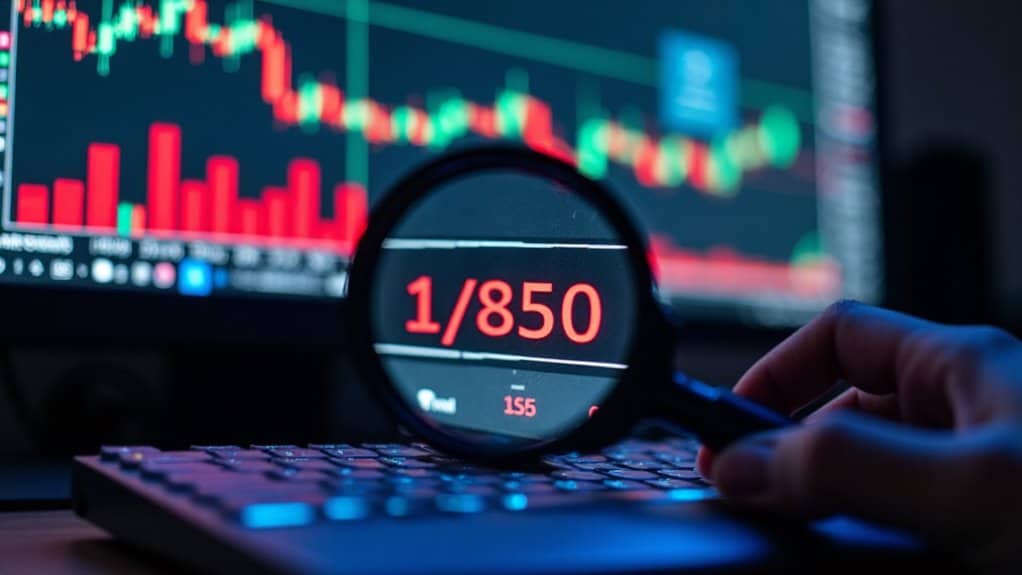In forex, a pip is the smallest standard price move, typically 0.0001 for pairs like EUR/USD; it’s how exchanges quote most currency prices and measures the spread (transaction cost). For JPY pairs, like USD/JPY, it’s usually 0.01. Fractional pips allow even finer tracking. Pips matter because they are the unit determining your potential profit, loss, and trading costs; learn more about their specific calculation impact ahead.
Defining the Core Concept of a Pip
In forex trading, a pip represents the smallest standardized increment a currency pair’s exchange rate can move. Think of one pip as the smallest price movement visible despite constant exchange rate fluctuations.
For most major pairs like EUR/USD, its pip size equals 0.0001, appearing at the fourth decimal place. This unit of measurement provides precision.
Your platform quotes using four decimal places for these currencies.
The distance between the bid and ask prices, known as the spread, is also denominated in pips. Understanding this value per pip allows you to assess transaction costs and potential profit/loss effectively.
Exceptions in JPY Pairs Pip Representation
Japanese yen pairs, like USD/JPY, represent a key exception to the standard 0.0001 pip definition. Here, one pip corresponds to a 0.01 price movement, meaning a move from 140.25 to 140.26 is a pip gain or loss. This notable exception exists because the low value of the Japanese yen historically made the smaller fraction impractical for trading convenience. When the quote currency is yen (like in USD/JPY), calculating the value of one pip involves the USD/JPY exchange rate.
| Feature | JPY Pairs |
|---|---|
| 1 Pip Movement | 0.01 |
| Pip Location | Second decimal place |
| Fractional Pip | Third decimal place |
| Base Value | Low value yen |
| Quote Currency Fix | Yen required adjustment |
Therefore, for yen pairs, your pip is equal to 0.01 instead of 0.0001.
Fractional Pips and Enhanced Price Precision
Beyond the standard pip, traders often use fractional pips (pipettes), which represent increments one-tenth the size of a pip.
These pipettes allow you to track tiny price changes to the fifth decimal place for most currency pairs quoted in pips.
For pairs like EUR/USD, priced out to four decimals normally, fractional pips provide the fifth decimal digit. JPY pairs, like USD/JPY, display fractional pips at the third decimal place.
This enhanced precision helps you identify smaller price moves, tight bid-ask spreads, and execute orders more accurately than a standard pip move permits.
Calculating Pip Values Across Currency Pairs
Calculating pip values changes depending on the currency pair traded and its quote currency.
For currency pairs where USD is the quote currency, like EUR/USD, the `value of a pip` per `standard lot size` (100,000 units) is typically $10; each `pip change` of `0.0001 (fourth decimal place)` equals $1 per 10k units.
With JPY) pairs, a `pip change` is `0.01`; you Calculate the Value as `(0.01 ÷ exchange rate) × trade size`. At USD/JPY 106.20 for 10,000 units, that’s `(0.01 ÷ 106.20) × 10,000 ≈ $0.94 per pip`.
For non-USD pairs, find the pip value first in the quote currency using `(pip change ÷ exchange rate) × trade size` then convert to USD.
Active pip in forex trading requires precise calculation awareness.
Practical Impact: How Pips Influence Profit and Loss
Because each pip movement directly impacts your trading account’s value, profit or loss hinges on the number of pips gained or lost. Your profit equals the change in pips multiplied by your position size and the pip value. For instance, gaining 50 pips on a $100,000 EUR/USD trade nets $500 profit (50 pips × $10 pip value). Conversely, a loss accumulates per pip moving against your position; e.g., watching USD/JPY rise 30 pips while short a 10,000-unit lot loses you $60.
Remember, you must overcome the spread before making profit, like a 1.3-pip EUR/USD spread.
Quantify risk using pips, such as a 20- pip GBP/USD stop loss representing a $200 risk per standard lot ($10/pip × 20 pips).
Borrowing magnifies pip impact; a 10-pip EUR/USD move with 50:1 Borrowing can cause 5% profit or loss on margin.
Conclusion
You now understand that a pip measures currency pair price changes, typically a 0.0001 shift for most pairs. Remember JPY pairs (like USD/JPY) quote pips as 0.01 due to yen valuation. Fractional pips (pipettes) provide finer market detail. Fundamentally, your profit or loss hinges directly on pip movement multiplied by precise unit value calculations based on position size and exchange rates. Knowing pip mechanics underpins essential trade management.


Leave a Reply